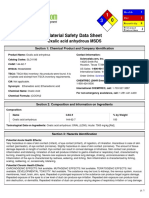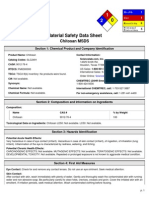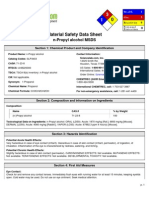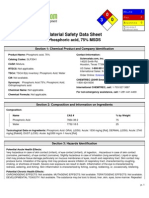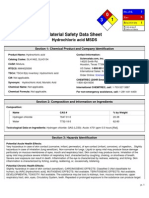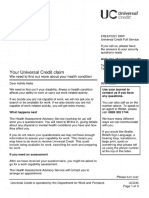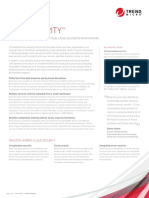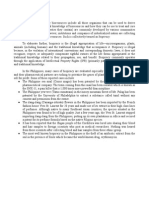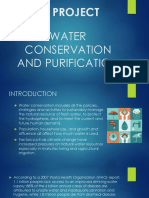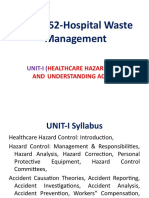Msds ASAM ASETAT
Msds ASAM ASETAT
Uploaded by
Adexs Navraty PoetriCopyright:
Available Formats
Msds ASAM ASETAT
Msds ASAM ASETAT
Uploaded by
Adexs Navraty PoetriOriginal Title
Copyright
Available Formats
Share this document
Did you find this document useful?
Is this content inappropriate?
Copyright:
Available Formats
Msds ASAM ASETAT
Msds ASAM ASETAT
Uploaded by
Adexs Navraty PoetriCopyright:
Available Formats
2 3
Material Safety Data Sheet
Acetic acid MSDS
Section 1: Chemical Product and Company Identification
Product Name: Acetic acid Catalog Codes: SLA3784, SLA1438, SLA2101, SLA3604, SLA1258 CAS#: 64-19-7 RTECS: AF1225000 TSCA: TSCA 8(b) inventory: Acetic acid CI#: Not applicable. Synonym: Acetic acid; glacial acetic acid Chemical Name: Acetic Acid, Glacial Chemical Formula: C2-H4-O2 Contact Information: Sciencelab.com, Inc. 14025 Smith Rd. Houston, Texas 77396 US Sales: 1-800-901-7247 International Sales: 1-281-441-4400 Order Online: ScienceLab.com
He a lt h
3 2 0 H
Fire Re a c t iv it y P e rs o n a l P ro t e c t io n
CHEMTREC (24HR Emergency Telephone), call: 1-800-424-9300 International CHEMTREC, call: 1-703-527-3887 For non-emergency assistance, call: 1-281-441-4400
Section 2: Composition and Information on Ingredients
Composition: Name Acetic acid CAS # 64-19-7 % by Weight 100
Toxicological Data on Ingredients: Acetic acid: ORAL (LD50): Acute: 3310 mg/kg [Rat]. 4960 mg/kg [Mouse]. 3530 mg/kg [Rat]. DERMAL (LD50): Acute: 1060 mg/kg [Rabbit]. VAPOR (LC50): Acute: 5620 ppm 1 hours [Mouse].
Section 3: Hazards Identification
Potential Acute Health Effects: Very hazardous in case of skin contact (irritant), of eye contact (irritant), of ingestion, of inhalation. Hazardous in case of skin contact (corrosive, permeator), of eye contact (corrosive). Liquid or spray mist may produce tissue damage particularly on mucous membranes of eyes, mouth and respiratory tract. Skin contact may produce burns. Inhalation of the spray mist may produce severe irritation of respiratory tract, characterized by coughing, choking, or shortness of breath. Inflammation of the eye is characterized by redness, watering, and itching. Skin inflammation is characterized by itching, scaling, reddening, or, occasionally, blistering. Potential Chronic Health Effects: Hazardous in case of skin contact (irritant), of ingestion, of inhalation. CARCINOGENIC EFFECTS: Not available. MUTAGENIC EFFECTS: Mutagenic for mammalian somatic cells. Mutagenic for bacteria and/or yeast. TERATOGENIC EFFECTS: Not available. DEVELOPMENTAL TOXICITY: Not available. The substance may be toxic to kidneys, mucous membranes, skin, teeth. Repeated or prolonged exposure to the substance can produce target organs damage. Repeated p. 1
or prolonged contact with spray mist may produce chronic eye irritation and severe skin irritation. Repeated or prolonged exposure to spray mist may produce respiratory tract irritation leading to frequent attacks of bronchial infection.
Section 4: First Aid Measures
Eye Contact: Check for and remove any contact lenses. In case of contact, immediately flush eyes with plenty of water for at least 15 minutes. Cold water may be used. Get medical attention immediately. Skin Contact: In case of contact, immediately flush skin with plenty of water for at least 15 minutes while removing contaminated clothing and shoes. Cover the irritated skin with an emollient. Cold water may be used.Wash clothing before reuse. Thoroughly clean shoes before reuse. Get medical attention immediately. Serious Skin Contact: Wash with a disinfectant soap and cover the contaminated skin with an anti-bacterial cream. Seek immediate medical attention. Inhalation: If inhaled, remove to fresh air. If not breathing, give artificial respiration. If breathing is difficult, give oxygen. Get medical attention immediately. Serious Inhalation: Evacuate the victim to a safe area as soon as possible. Loosen tight clothing such as a collar, tie, belt or waistband. If breathing is difficult, administer oxygen. If the victim is not breathing, perform mouth-to-mouth resuscitation. WARNING: It may be hazardous to the person providing aid to give mouth-to-mouth resuscitation when the inhaled material is toxic, infectious or corrosive. Seek immediate medical attention. Ingestion: Do NOT induce vomiting unless directed to do so by medical personnel. Never give anything by mouth to an unconscious person. Loosen tight clothing such as a collar, tie, belt or waistband. Get medical attention if symptoms appear. Serious Ingestion: Not available.
Section 5: Fire and Explosion Data
Flammability of the Product: Flammable. Auto-Ignition Temperature: 463C (865.4F) Flash Points: CLOSED CUP: 39C (102.2F). OPEN CUP: 43C (109.4F). Flammable Limits: LOWER: 4% UPPER: 19.9% Products of Combustion: These products are carbon oxides (CO, CO2). Fire Hazards in Presence of Various Substances: Flammable in presence of open flames and sparks, of heat. Slightly flammable to flammable in presence of oxidizing materials, of metals. Explosion Hazards in Presence of Various Substances: Risks of explosion of the product in presence of mechanical impact: Not available. Risks of explosion of the product in presence of static discharge: Not available. Slightly explosive in presence of oxidizing materials. Fire Fighting Media and Instructions: Flammable liquid, soluble or dispersed in water. SMALL FIRE: Use DRY chemical powder. LARGE FIRE: Use alcohol foam, water spray or fog. Cool containing vessels with water jet in order to prevent pressure build-up, autoignition or explosion. Special Remarks on Fire Hazards: Reacts with metals to produces flammable hydrogen gas. It will ignite on contact with potassium-tert-butoxide. A mixture of ammonium nitrate and acetic acid ignites when warmed, especially if warmed. Special Remarks on Explosion Hazards: p. 2
Acetic acid vapors may form explosive mixtures with air. Reactions between acetic acid and the following materials are potentially explosive: 5-azidotetrazole, bromine pentafluoride, chromium trioxide, hydrogen peroxide, potassium permanganate, sodium peroxide, and phorphorus trichloride. Dilute acetic acid and dilute hydrogen can undergo an exothermic reaction if heated, forming peracetic acid which is explosive at 110 degrees C. Reaction between chlorine trifluoride and acetic acid is very violent, sometimes explosive.
Section 6: Accidental Release Measures
Small Spill: Dilute with water and mop up, or absorb with an inert dry material and place in an appropriate waste disposal container. If necessary: Neutralize the residue with a dilute solution of sodium carbonate. Large Spill: Flammable liquid. Corrosive liquid. Keep away from heat. Keep away from sources of ignition. Stop leak if without risk. If the product is in its solid form: Use a shovel to put the material into a convenient waste disposal container. If the product is in its liquid form: Absorb with DRY earth, sand or other non-combustible material. Do not get water inside container. Absorb with an inert material and put the spilled material in an appropriate waste disposal. Do not touch spilled material. Use water spray curtain to divert vapor drift. Prevent entry into sewers, basements or confined areas; dike if needed. Call for assistance on disposal. Neutralize the residue with a dilute solution of sodium carbonate. Be careful that the product is not present at a concentration level above TLV. Check TLV on the MSDS and with local authorities.
Section 7: Handling and Storage
Precautions: \Keep away from heat. Keep away from sources of ignition. Ground all equipment containing material. Do not ingest. Do not breathe gas/fumes/ vapor/spray. Never add water to this product. In case of insufficient ventilation, wear suitable respiratory equipment. If ingested, seek medical advice immediately and show the container or the label. Avoid contact with skin and eyes. Keep away from incompatibles such as oxidizing agents, reducing agents, metals, acids, alkalis. Storage: Store in a segregated and approved area. Keep container in a cool, well-ventilated area. Keep container tightly closed and sealed until ready for use. Avoid all possible sources of ignition (spark or flame).
Section 8: Exposure Controls/Personal Protection
Engineering Controls: Provide exhaust ventilation or other engineering controls to keep the airborne concentrations of vapors below their respective threshold limit value. Ensure that eyewash stations and safety showers are proximal to the work-station location. Personal Protection: Splash goggles. Synthetic apron. Vapor respirator. Be sure to use an approved/certified respirator or equivalent. Gloves (impervious). Personal Protection in Case of a Large Spill: Splash goggles. Full suit. Vapor respirator. Boots. Gloves. A self contained breathing apparatus should be used to avoid inhalation of the product. Suggested protective clothing might not be sufficient; consult a specialist BEFORE handling this product. Exposure Limits: TWA: 10 STEL: 15 (ppm) [Australia] TWA: 25 STEL: 27 (mg/m3) [Australia] TWA: 10 STEL: 15 (ppm) from NIOSH TWA: 25 STEL: 37 (mg/m3) from NIOSH TWA: 10 STEL: 15 (ppm) [Canada] TWA: 26 STEL: 39 (mg/m3) [Canada] TWA: 25 STEL: 37 (mg/m3) TWA: 10 STEL: 15 (ppm) from ACGIH (TLV) [United States] [1999] TWA: 10 (ppm) from OSHA (PEL) [United States] TWA: 25 (mg/m3) from OSHA (PEL) [United States]Consult local authorities for acceptable exposure limits.
Section 9: Physical and Chemical Properties
p. 3
Physical state and appearance: Liquid. Odor: Pungent, vinegar-like, sour (Strong.) Taste: Vinegar, sour (Strong.) Molecular Weight: 60.05 g/mole Color: Colorless. Clear (Light.) pH (1% soln/water): 2 [Acidic.] Boiling Point: 118.1C (244.6F) Melting Point: 16.6C (61.9F) Critical Temperature: 321.67C (611F) Specific Gravity: 1.049 (Water = 1) Vapor Pressure: 1.5 kPa (@ 20C) Vapor Density: 2.07 (Air = 1) Volatility: Not available. Odor Threshold: 0.48 ppm Water/Oil Dist. Coeff.: The product is more soluble in water; log(oil/water) = -0.2 Ionicity (in Water): Not available. Dispersion Properties: See solubility in water, diethyl ether, acetone. Solubility: Easily soluble in cold water, hot water. Soluble in diethyl ether, acetone. Miscible with Glycerol, alcohol, Benzene, Carbon Tetrachloride. Practically insoluble in Carbon Disulfide.
Section 10: Stability and Reactivity Data
Stability: The product is stable. Instability Temperature: Not available. Conditions of Instability: Heat, ignition sources, incompatible materials Incompatibility with various substances: Reactive with oxidizing agents, reducing agents, metals, acids, alkalis. Corrosivity: Highly corrosive in presence of stainless steel(304). Slightly corrosive in presence of aluminum, of copper. Non-corrosive in presence of stainless steel(316). Special Remarks on Reactivity: Reacts violently with strong oxidizing agents, acetaldehyde, and acetic anhydride. Material can react with metals, strong bases, amines, carbonates, hydroxides, phosphates, many oxides,cyanides, sulfides, chromic acid, nitric acid, hydrogen peroxide, carbonates. ammonium nitrate, ammonium thiosulfate, chlorine trifluoride, chlorosulfonic acid, perchloric acid, permanganates, xylene, oleum, potassium hydroxide, sodium hydroxide, phosphorus isocyanate, ethylenediamine, ethylene imine. Special Remarks on Corrosivity: Moderate corrosive effect on bronze. No corrosion data on brass Polymerization: Will not occur.
Section 11: Toxicological Information
Routes of Entry: Absorbed through skin. Dermal contact. Eye contact. Inhalation. Ingestion. p. 4
Toxicity to Animals: WARNING: THE LC50 VALUES HEREUNDER ARE ESTIMATED ON THE BASIS OF A 4-HOUR EXPOSURE. Acute oral toxicity (LD50): 3310 mg/kg [Rat]. Acute dermal toxicity (LD50): 1060 mg/kg [Rabbit]. Acute toxicity of the vapor (LC50): 5620 1 hours [Mouse]. Chronic Effects on Humans: MUTAGENIC EFFECTS: Mutagenic for mammalian somatic cells. Mutagenic for bacteria and/or yeast. May cause damage to the following organs: kidneys, mucous membranes, skin, teeth. Other Toxic Effects on Humans: Extremely hazardous in case of inhalation (lung corrosive). Very hazardous in case of skin contact (irritant), of ingestion, . Hazardous in case of skin contact (corrosive, permeator), of eye contact (corrosive). Special Remarks on Toxicity to Animals: Not available. Special Remarks on Chronic Effects on Humans: May affect genetic material and may cause reproductive effects based on animal data. No human data found. Special Remarks on other Toxic Effects on Humans: Acute Potential Health Effects: Skin: Extremely irritating and corrosive. Causes skin irritation (reddening and itching, inflammation). May cause blistering , tissue damage and burns. Eyes: Extremely irritating and corrosive. Causes eye irritation, lacrimation, redness, and pain. May cause burns, blurred vision, conjunctivitis, conjunctival and corneal destruction and permanent injury. Inhalation: Causes severe respiratory tract irritation. Affects the sense organs (nose, ear, eye, taste), and blood. May cause chemical pneumonitis, bronchitis, and pulmonary edema. Severe exposure may result in lung tissue damage and corrosion (ulceration) of the mucous membranes. Inhalation may also cause rhinitis, sneezing, coughing, oppressive feeling in the chest or chest pain, dyspnea, wheezing, tachypnea, cyanosis, salivation, nausea, giddiness, muscular weakness. Ingestion: Moderately toxic. Corrosive. Causes gastrointestinal tract irritation (burning and pain of the mouth, throat, and abdomen, coughing, ulceration, bleeding, nausea, abdomial spasms, vomiting, hematemesis, diarrhea. May Also affect the liver (impaired liver function), behavior (convulsions, giddines, muscular weakness), and the urinary system - kidneys (Hematuria, Albuminuria, Nephrosis, acute renal failure, acute tubular necrosis). May also cause dyspnea or asphyxia. May also lead to shock, coma and death. Chronic Potential Health Effects: Chronic exposure via ingestion may cause blackening or erosion of the teeth and jaw necrosis, pharyngitis, and gastritis. It may also behavior (similar to acute ingestion), and metabolism (weight loss). Chronic exposure via inhalation may cause asthma and/or bronchitis with cough, phlegm, and/or shortness of breath . It may also affect the blood (decreased leukocyte count), and urinary system (kidneys). Repeated or prolonged skin contact may cause thickening, blackening, and cracking of the skin.
Section 12: Ecological Information
Ecotoxicity: Ecotoxicity in water (LC50): 423 mg/l 24 hours [Fish (Goldfish)]. 88 ppm 96 hours [Fish (fathead minnow)]. 75 ppm 96 hours [Fish (bluegill sunfish)]. >100 ppm 96 hours [Daphnia]. BOD5 and COD: BOD-5: 0.34-0.88 g oxygen/g Products of Biodegradation: Possibly hazardous short term degradation products are not likely. However, long term degradation products may arise. Toxicity of the Products of Biodegradation: The products of degradation are less toxic than the product itself. Special Remarks on the Products of Biodegradation: Not available.
Section 13: Disposal Considerations
Waste Disposal: Waste must be disposed of in accordance with federal, state and local environmental control regulations.
Section 14: Transport Information
DOT Classification: p. 5
CLASS 3: Flammable liquid. Class 8: Corrosive material Identification: : Acetic Acid, Glacial UNNA: 2789 PG: II Special Provisions for Transport: Not available.
Section 15: Other Regulatory Information
Federal and State Regulations: New York release reporting list: Acetic acid Rhode Island RTK hazardous substances: Acetic acid Pennsylvania RTK: Acetic acid Florida: Acetic acid Minnesota: Acetic acid Massachusetts RTK: Acetic acid New Jersey: Acetic acid California Director's List of Hazardous Subtances (8 CCR 339): Acetic acid TSCA 8(b) inventory: Acetic acid CERCLA: Hazardous substances.: Acetic acid: 5000 lbs. (2268 kg) Other Regulations: OSHA: Hazardous by definition of Hazard Communication Standard (29 CFR 1910.1200). EINECS: This product is on the European Inventory of Existing Commercial Chemical Substances. Other Classifications: WHMIS (Canada): CLASS B-3: Combustible liquid with a flash point between 37.8C (100F) and 93.3C (200F). CLASS E: Corrosive liquid. DSCL (EEC): R10- Flammable. R35- Causes severe burns. S23- Do not breathe gas/fumes/vapour/spray [***] S26- In case of contact with eyes, rinse immediately with plenty of water and seek medical advice. S45- In case of accident or if you feel unwell, seek medical advice immediately (show the label where possible). HMIS (U.S.A.): Health Hazard: 3 Fire Hazard: 2 Reactivity: 0 Personal Protection: H National Fire Protection Association (U.S.A.): Health: 3 Flammability: 2 Reactivity: 0 Specific hazard: Protective Equipment: Gloves (impervious). Synthetic apron. Vapor respirator. Be sure to use an approved/certified respirator or equivalent. Wear appropriate respirator when ventilation is inadequate. Splash goggles.
Section 16: Other Information
References: Not available. Other Special Considerations: Not available. Created: 10/09/2005 03:35 PM Last Updated: 11/01/2010 12:00 PM The information above is believed to be accurate and represents the best information currently available to us. However, we make no warranty of merchantability or any other warranty, express or implied, with respect to such information, and we assume p. 6
no liability resulting from its use. Users should make their own investigations to determine the suitability of the information for their particular purposes. In no event shall ScienceLab.com be liable for any claims, losses, or damages of any third party or for lost profits or any special, indirect, incidental, consequential or exemplary damages, howsoever arising, even if ScienceLab.com has been advised of the possibility of such damages.
p. 7
You might also like
- Potassium Dichromate MSDS: Section 1: Chemical Product and Company IdentificationDocument6 pagesPotassium Dichromate MSDS: Section 1: Chemical Product and Company IdentificationRicky SetiawanNo ratings yet
- MSDS KloroformDocument6 pagesMSDS KloroformdiantikaNo ratings yet
- Hydrochloric Acid MSDS: Section 1: Chemical Product and Company IdentificationDocument7 pagesHydrochloric Acid MSDS: Section 1: Chemical Product and Company IdentificationDery RachmandaniNo ratings yet
- Pre Invoice PDFDocument2 pagesPre Invoice PDFVinayNo ratings yet
- Msds HCLDocument7 pagesMsds HCLbagus kustantoNo ratings yet
- Msds Etanol 2005Document7 pagesMsds Etanol 2005Puput Trisnayanti Inanto PutriNo ratings yet
- Asam Oksalat (C2H2O4)Document6 pagesAsam Oksalat (C2H2O4)Dini HandayaniNo ratings yet
- Msds Kalium DikromatDocument6 pagesMsds Kalium DikromatKeynan HaqieNo ratings yet
- Msds K2cro4 PDFDocument6 pagesMsds K2cro4 PDFAnonymous U0RczPNo ratings yet
- MSDS Na2S2O3 PDFDocument5 pagesMSDS Na2S2O3 PDFIza Nur MeiliaNo ratings yet
- Sodium Acetate MsdsDocument5 pagesSodium Acetate MsdsMehmet Besim SacilikNo ratings yet
- MSDS Na2S2O3Document5 pagesMSDS Na2S2O3Ria YuliaNo ratings yet
- Acetophenon PDFDocument6 pagesAcetophenon PDFYuris Yurdiansah Munandar0% (1)
- Msds Buffer PH 10 BlueDocument5 pagesMsds Buffer PH 10 BlueMuhammad Irfan MalikNo ratings yet
- Msds Fehling BDocument6 pagesMsds Fehling BndutpesekNo ratings yet
- Urea MSDS: Section 1: Chemical Product and Company IdentificationDocument5 pagesUrea MSDS: Section 1: Chemical Product and Company IdentificationFadli ApriantoNo ratings yet
- Methyl Red MSDSDocument6 pagesMethyl Red MSDSm fermiNo ratings yet
- Fehling Solution A MSDSDocument5 pagesFehling Solution A MSDSindra suryanaNo ratings yet
- Msds Kalium Iodida (Ki)Document6 pagesMsds Kalium Iodida (Ki)FajarSholikhin100% (3)
- Zeolit PDFDocument5 pagesZeolit PDFYuniAnggraeniNo ratings yet
- MSDS HeksanaDocument6 pagesMSDS HeksanadiantikaNo ratings yet
- Msds BaCl2Document5 pagesMsds BaCl2Muhsin Mukhtar S. FarmNo ratings yet
- Msds NaOH Natrium HidroksidaDocument6 pagesMsds NaOH Natrium HidroksidasilviaNo ratings yet
- Msds Zinc Sulphate 0.05MDocument5 pagesMsds Zinc Sulphate 0.05MNicholas ChanNo ratings yet
- Albumin, Egg MSDS: Section 1: Chemical Product and Company IdentificationDocument5 pagesAlbumin, Egg MSDS: Section 1: Chemical Product and Company IdentificationSefin Nur AisyahNo ratings yet
- MSDS Na2HPO4 (Monosodium Phospate) Atau Disodium Dihydrogen Phospate)Document5 pagesMSDS Na2HPO4 (Monosodium Phospate) Atau Disodium Dihydrogen Phospate)darmayunitaNo ratings yet
- Msds KitosanDocument5 pagesMsds KitosanNuky Dwifirly Pratiwi ArhathaNo ratings yet
- PDF Phenolphthalein Powder Msds Section 1 Chemical Product and Company IdentificationDocument6 pagesPDF Phenolphthalein Powder Msds Section 1 Chemical Product and Company IdentificationM Rizki AbidNo ratings yet
- MSDS - Ammonium Chloride, 2.0 M MSDSDocument6 pagesMSDS - Ammonium Chloride, 2.0 M MSDSEarl Learned MagicNo ratings yet
- Msds Cacl2 AnhidratDocument5 pagesMsds Cacl2 AnhidratArfin FardiansyahNo ratings yet
- Msds NH4ClDocument6 pagesMsds NH4Cl2imaNo ratings yet
- MSDS AlCl3Document5 pagesMSDS AlCl3Ira Maya Tri MurningsihNo ratings yet
- Material Safety Data Sheet: Section 1 - Chemical Product and Company IdentificationDocument6 pagesMaterial Safety Data Sheet: Section 1 - Chemical Product and Company IdentificationRahasia Tahu RahasiaNo ratings yet
- Msds Naftalena PDFDocument6 pagesMsds Naftalena PDFFajarWidyawanNo ratings yet
- Msds PropanolDocument6 pagesMsds PropanolDasa HaryuwibawaNo ratings yet
- Na 2 CO3Document6 pagesNa 2 CO3mariyana kusumawatiNo ratings yet
- MSDS ZNDocument6 pagesMSDS ZNAulia RhamdaniNo ratings yet
- Potassium Bromide MSDS: Section 1: Chemical Product and Company IdentificationDocument5 pagesPotassium Bromide MSDS: Section 1: Chemical Product and Company IdentificationFirda jihanNo ratings yet
- Msds Kloroform)Document6 pagesMsds Kloroform)Muhammad SaprizalNo ratings yet
- MSDS MgCl2Document5 pagesMSDS MgCl2Hizba N100% (1)
- Msds Buffer AsetatDocument6 pagesMsds Buffer AsetatAnnisa SeptianiNo ratings yet
- Cacl 2Document5 pagesCacl 2Ahmed Qomaruddin100% (1)
- Resorcinol MSDS: Section 1: Chemical Product and Company IdentificationDocument6 pagesResorcinol MSDS: Section 1: Chemical Product and Company IdentificationheriantosdbNo ratings yet
- Msds GliserolDocument5 pagesMsds Gliserolalchemiy100% (1)
- Phosphoric Acid, 85% MSDS: Section 1: Chemical Product and Company IdentificationDocument6 pagesPhosphoric Acid, 85% MSDS: Section 1: Chemical Product and Company IdentificationChemicalB0yNo ratings yet
- Msds Phosphoric AcidDocument6 pagesMsds Phosphoric AcidSuresh RamanathanNo ratings yet
- Hydrochloric Acid MSDS: Section 1: Chemical Product and Company IdentificationDocument7 pagesHydrochloric Acid MSDS: Section 1: Chemical Product and Company IdentificationMarbert PinqueNo ratings yet
- Asam PikratDocument6 pagesAsam PikratEdi MahmudahNo ratings yet
- MsdsDocument6 pagesMsdsKevin EsmunaldoNo ratings yet
- MSDS H2so4Document7 pagesMSDS H2so4Shelly Trissa RamadhanNo ratings yet
- H2so4 PDFDocument7 pagesH2so4 PDFwafiyatusNo ratings yet
- Picric Acid PDFDocument6 pagesPicric Acid PDFTaufiq Nur RachmanNo ratings yet
- MSDS - AgNO3Document6 pagesMSDS - AgNO3Fischer01No ratings yet
- Acetone MSDS: Section 1: Chemical Product and Company IdentificationDocument7 pagesAcetone MSDS: Section 1: Chemical Product and Company IdentificationRanskuy YTNo ratings yet
- Msds Kmno4Document6 pagesMsds Kmno4Gilang RamadhanNo ratings yet
- AsetonDocument6 pagesAsetonMutia Nurul OctaviaNo ratings yet
- MsdsDocument6 pagesMsdsRoby SuheriNo ratings yet
- Msds SnCl2Document6 pagesMsds SnCl2Dwi Putri W. PamungkasNo ratings yet
- HCL 37 %Document7 pagesHCL 37 %Yohana MelianthaNo ratings yet
- Alcohol MetílicoDocument6 pagesAlcohol MetílicoelpaulobaqueroNo ratings yet
- Complexes of Metal Ions and Nomenclature For Inorganic CompoundsDocument22 pagesComplexes of Metal Ions and Nomenclature For Inorganic CompoundsyulliarperezNo ratings yet
- Factors Affecting Human Body TemperatureDocument5 pagesFactors Affecting Human Body TemperatureHaya Tarek BedewiNo ratings yet
- Establishment CodeDocument1,530 pagesEstablishment CodesindhujattNo ratings yet
- Full Download of Test Bank for Molecular Biology of the Cell Sixth Edition in PDF DOCX FormatDocument57 pagesFull Download of Test Bank for Molecular Biology of the Cell Sixth Edition in PDF DOCX Formatarmiolokite100% (3)
- Answer The Questions by Choosing A, B, C or D:: Chairman of Literature ClubDocument6 pagesAnswer The Questions by Choosing A, B, C or D:: Chairman of Literature ClubIlyasa NazhiifNo ratings yet
- Research On Sleep Deprivation Among Filipino Teenage StudentsDocument26 pagesResearch On Sleep Deprivation Among Filipino Teenage StudentsErjoy Constantine RoblesNo ratings yet
- LILY BASICS - Part 2 - Morphology W PhotosDocument2 pagesLILY BASICS - Part 2 - Morphology W PhotosEssay NationNo ratings yet
- Anatomy MUHS PAPERSDocument26 pagesAnatomy MUHS PAPERSJayesh PawarNo ratings yet
- MSDS QS 705 - 020110Document2 pagesMSDS QS 705 - 020110Jet ToledoNo ratings yet
- Chemical Methods of ImobilizationDocument5 pagesChemical Methods of ImobilizationJyotishna SinghNo ratings yet
- UCD35 Ashifa HatiaDocument3 pagesUCD35 Ashifa Hatiaashifa hatiaNo ratings yet
- 22 August 2020 Schedule Eac Psych 3Document3 pages22 August 2020 Schedule Eac Psych 3Dhruva PatelNo ratings yet
- Guidance Note: Design, Installation, Commissioning and Maintenance of Aspirating Smoke Detector (ASD) SystemsDocument70 pagesGuidance Note: Design, Installation, Commissioning and Maintenance of Aspirating Smoke Detector (ASD) SystemsRichard torresNo ratings yet
- Deep Security Datasheet enDocument4 pagesDeep Security Datasheet enaforabadNo ratings yet
- Vallourec IPC-207Document4 pagesVallourec IPC-207zapspazNo ratings yet
- Filipino 4th Quarter Grade 8Document5 pagesFilipino 4th Quarter Grade 8notsarahmwamwaNo ratings yet
- BIO-PIRacy Ethics 10Document3 pagesBIO-PIRacy Ethics 10March ElleneNo ratings yet
- Quantmasters TCS NQT 2021 Solutions To Verbal Ability Slot 1 8-11 AMDocument7 pagesQuantmasters TCS NQT 2021 Solutions To Verbal Ability Slot 1 8-11 AMGayatri Bagade0% (1)
- Technical Guide Change ControlDocument42 pagesTechnical Guide Change Controltito1628No ratings yet
- DM74123 Dual Retriggerable One-Shot With Clear and Complementary OutputsDocument5 pagesDM74123 Dual Retriggerable One-Shot With Clear and Complementary Outputsrotero_pujolNo ratings yet
- Iip Project: Water Conservation and PurificationDocument9 pagesIip Project: Water Conservation and PurificationTanmay DagaNo ratings yet
- Salah or Prayer Is One of The Pillars of Islam and It Is AnDocument7 pagesSalah or Prayer Is One of The Pillars of Islam and It Is AnSitti Nauhar AukasaNo ratings yet
- Unit 1 Hazard Control Management ResponsibilityDocument20 pagesUnit 1 Hazard Control Management ResponsibilityAusrutha Sangaiya0% (1)
- Osho Dynamic MeditationDocument1 pageOsho Dynamic Meditationallan74100% (1)
- To Surface Integrity: General. ElectricDocument7 pagesTo Surface Integrity: General. ElectricYashas KattemaneNo ratings yet
- Nato Quality Assurance Requirements For Inspection and Test: AQAP 2130 (Edition 1)Document18 pagesNato Quality Assurance Requirements For Inspection and Test: AQAP 2130 (Edition 1)Bahadır HarmancıNo ratings yet
- Case Study-Risk Mitigation in Remedial H PDFDocument18 pagesCase Study-Risk Mitigation in Remedial H PDFjcNo ratings yet
- Everest Base Camp Trek PDFDocument4 pagesEverest Base Camp Trek PDFDipesh NeupaneNo ratings yet
- Philippine Magazine April, 1940 Vol. XXXVIIDocument40 pagesPhilippine Magazine April, 1940 Vol. XXXVIIKathleen J. Burkhalter100% (1)






